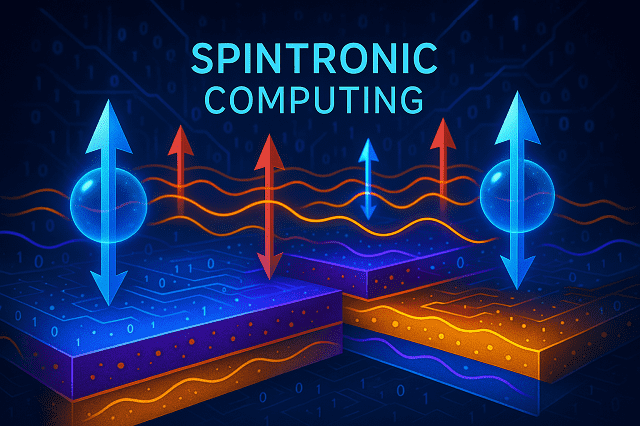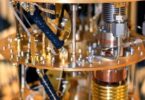What is Spintronic Computing?
Define Spintronic Computing in Simple Terms
Spintronic computing is spin-based electronics in short. Spin-based electronics is an emerging technology. It leverages the intrinsic spin of electrons—along with their electric charge. The intrinsic spin of electrons helps to process and store information. In simple terms, traditional computers use the charge of electrons (either present or absent, representing binary 1s and 0s) to perform operations. Spintronic computing, on the other hand, uses an additional property of electrons—their spin—which can be “up” or “down.” This dual nature enables more complex data representation, higher efficiency, and faster processing.
Spintronics manipulate the spin state of electrons in specially designed materials. Spintronics opens the door to non-volatile, low-power, and ultra-fast computing systems. It is a revolutionary approach. This approach could redefine how data is handled at the physical level in everything from smartphones to supercomputers.
Importance in the Evolution of Modern Computing
We already hit the physical and thermal limits of traditional silicon-based computing. Spintronics steps in as a next-generation solution. Here is why it matters:
- Energy Efficiency: Spintronic devices consume far less power compared to conventional transistors. That makes them ideal for battery-powered and eco-friendly applications.
- Non-Volatility: Data stored using spin can be retained even when the power is off. That enables instant-on computing and more robust memory systems.
- Faster Data Processing: The ability to read and write spin states rapidly means quicker computation speeds and enhanced system performance.
- Miniaturization: Spintronic components can be made incredibly small. Those small Spintronic components can support the ongoing push toward smaller, faster, and more powerful electronics.
In short, Spintronic computing could be the key to overcoming the limitations of Moore’s Law. It can enable future-ready computing architectures.
How Spintronic Differs from Traditional Electronics:
At the heart of the difference is how information is represented and manipulated:
| Feature | Traditional Electronics | Spintronic Computing |
| Information Carrier | Electron charge | Electron spin (plus charge) |
| Binary Representation | High/low voltage (0 or 1) | Spin-up/spin-down |
| Power Consumption | Higher | Significantly lower |
| Data Retention | Volatile (needs constant power) | Non-volatile (retains data) |
| Speed and Efficiency | Limited by electrical resistance | Higher due to reduced energy loss |
Traditional electronics rely solely on the movement of charge (resulting in heat and energy loss). However, Spintronic devices aim to reduce energy waste by controlling spin states with magnetic fields or spin currents. That is a far more efficient mechanism.
This fundamental shift in how data is processed and stored gives edge to Spintronics. That is the world’s demand for high-speed, low-power, and compact computing solutions.
The Science Behind Spintronics
What is Electron Spin and How It is Used
To understand Spintronic computing, we need to begin at the quantum level. The electrons not only carry a negative charge. They also possess a unique quantum property known as “spin.” This “spin” is not literal rotation like a planet. It is rather a quantized form of angular momentum that gives each electron a small magnetic field.
Spin States:
Electrons can exist in one of two spin states:
- Spin-Up (↑) — aligned in one direction
- Spin-Down (↓) — aligned in the opposite direction
These two states can be used to represent binary information:
- 1 = Spin-Up
- 0 = Spin-Down
In traditional computing the presence or absence of charge is used for logic states. Spintronic computing takes this a step further by encoding data into the spin state. It allows operations to be:
- Faster
- More energy-efficient
- Non-volatile (data does not disappear when power is off)
How Spin Is Controlled:
Manipulating electron spin is possible through:
- External Magnetic Fields – align the spins within materials
- Spin Injection – transferring spin-polarized electrons into non-magnetic materials
- Spin-Orbit Coupling –It is the interaction between an electron’s motion and spin. Spin-Orbit Coupling is useful in designing spin filters and memory devices.
- Electric Currents – using spin-polarized currents to read/write data in memory (MRAM)
Spintronic devices are capable of read and write operations without needing to constantly move large amounts of charge. It drastically lowers energy consumption and enables faster switching.
Spintronic Materials and Magnetoresistance
Spintronic technology hinges on the interaction of electron spin with magnetic materials. Let us break down two essential components: materials and magnetoresistance phenomena.
-
Key Spintronic Materials:
To build spin-based circuits, we need materials that exhibit precise magnetic properties:
- Ferromagnetic Metals (Iron, Cobalt, and Nickel): Electrons in these materials tend to align their spins in the same direction. That produces strong magnetic effects.
- Half-Metals: Special materials that conduct electrons of only one spin orientation. They act like a natural spin filter.
- Magnetic Tunnel Junctions (MTJs): Structures made of two ferromagnetic layers separated by a thin insulating layer used in MRAM.
-
Magnetoresistance Explained:
Magnetoresistance is a change in electrical resistance based on magnetic alignment. It is the core phenomenon exploited in many Spintronic devices.
Giant Magnetoresistance (GMR):
- Giant Magnetoresistance is discovered in 1988. GMR is the basis of Spintronic read heads in hard drives.
- In GMR, the resistance varies depending on whether the magnetic layers are parallel (low resistance) or antiparallel (high resistance).
- This allows bits to be read based on spin orientation—without needing charge flow changes.
Tunneling Magnetoresistance (TMR):
- Utilizes quantum tunneling through a thin insulating layer.
- Resistance changes when spins in adjacent magnetic layers align or oppose.
- TMR enables non-volatile, high-speed memory, as seen in MRAM (Magnetoresistive RAM).
These effects make it possible to design memory and logic circuits where data is stored in spin states and read by resistance changes. Further, it eliminates the need for frequent refreshes or high current flows.
Comparison with Conventional Charge-Based Computing
Understanding how Spintronics can compare with traditional computing is essential for grasping its revolutionary potential.
Power Efficiency:
- Conventional electronics require constant current flow. That leads to heat buildup and energy loss.
- Spintronic devices retain data using magnetic spin states. A Spintronic device does not need continuous current. That is drastically reducing power consumption.
Data Retention:
- DRAM and SRAM are volatile. That means they lose all data when the power is off.
- MRAM and other Spintronic memories are non-volatile. Therefore, the data persists even when the system is shut down.
Processing Speed:
- Spintronic devices offer faster read/write times in memory.
- The use of electron spin allows for parallel processing and quicker data access.
Miniaturization & Scalability:
- When transistor sizes shrink below 5nm then the quantum effects disrupt traditional charge-based designs.
- Spintronic materials and devices can be scaled down more effectively and may even operate at atomic levels. That is promising a longer lifespan for Moore’s Law.
Summary Table:
| Feature | Charge-Based Computing | Spintronic Computing |
| Information Medium | Electron charge | Electron spin |
| Power Consumption | High (due to continuous current) | Low (data retained without power) |
| Volatility | Volatile (DRAM) | Non-volatile (MRAM) |
| Data Processing Speed | Moderate (affected by heat/resistance) | Fast (less heat, direct spin switching) |
| Thermal Management | Difficult at scale | Easier due to lower energy use |
| Device Scaling | Hitting limits below 5nm | More scalable with magnetic materials |
Thoughts on the Science
Spintronics fundamentally transforms our understanding of how information can be stored and manipulated at the quantum level. It is replacing or augmenting the role of charge with spin. Spintronics enables energy-efficient, fast, and non-volatile computing. That is potentially paving the way for future technologies like:
- Neuromorphic computing
- Brain-inspired AI hardware
- Energy-saving data centers
- Wearables with instant-on capability
Brief History of Spintronics: From Physics to Computing Revolution
The journey of Spintronics or spin-based electronics is a fascinating evolution. It brings together quantum physics, materials science, and computer engineering. The idea of exploiting electron spin dates back several decades. The practical breakthroughs have only emerged in recent years. It is paving the way for real-world applications in computing.
1960s–1970s: Theoretical Foundations
The concept of electron spin emerged from quantum mechanics in the early 20th century. However, it was not known until the 1960s and 1970s those scientists began to seriously consider spin as a usable property in solid-state devices. These early years were focused primarily on understanding spin dynamics in metals and semiconductors. That is laying the groundwork for future discoveries.
1988: The Discovery of Giant Magnetoresistance (GMR)
A pivotal moment in Spintronics occurred when Albert Fert (France) and Peter Grünberg (Germany) independently discovered Giant Magnetoresistance (GMR). GMR is a quantum effect where the electrical resistance of certain materials changes drastically in the presence of a magnetic field.
- Their work earned them the 2007 Nobel Prize in Physics. GMR became the first practical application of Spintronics. That is revolutionizing data storage.
- GMR heads were soon adopted in hard drives. Those GMR heads will enable a huge leap in data density.
1990s: Rise of Spintronic Research
The success of GMR sparked intense global research into other spin-dependent phenomena, including:
- Tunnel Magnetoresistance (TMR)
- Spin injection and spin transport in semiconductors
- Spin valves and magnetic multilayers
This era also saw the development of the first MRAM prototypes. It is aimed at replacing conventional RAM with faster, non-volatile alternatives.
2000s: MRAM Commercialization and Industry Adoption
By the early 2000s, companies like IBM, Hitachi, Motorola, and Samsung began developing commercial MRAM (Magnetoresistive Random-Access Memory) based on Spintronic principles.
- MRAM offers benefits like non-volatility, high endurance, and low power. MRAM is catching the attention of sectors like aerospace, military, and mobile.
2010s: Advanced Spintronic Devices & Logic Circuits
Research advanced from memory to logic and processing components using spin. Key innovations included:
- Spin transistors
- Spin Hall effect
- Spin-orbit torque (SOT) switching
- Topological insulators for spin control
These developments opened the door to spin-based logic circuits. Those developments promise to replace or complement CMOS technology in high-performance, low-power applications.
The 2020s and Beyond: Toward a Spintronic Computing Era
Spintronics is now seen as a core technology for:
- Next-generation memory (STT-MRAM, SOT-MRAM)
- AI accelerators
- Neuromorphic computing
- Quantum-class hybrid systems
With continued breakthroughs in spin materials, room-temperature spin manipulation, and CMOS-compatible fabrication, Spintronic computing is moving from research labs to the commercial world. That is poised to be a foundational pillar of future electronics.
Key Components of Spintronic Devices
Spintronic computing is not a vague futuristic concept anymore. It is being realized through a set of powerful hardware components. Each of these elements is rooted in manipulating electron spin to achieve faster, more efficient, and non-volatile operations.
MRAM (Magnetoresistive Random-Access Memory)
A Closer Look at MRAM Architecture
At the core of MRAM lies the Magnetic Tunnel Junction (MTJ). Imagine it as a sandwich:
- Top Layer: Free magnetic layer (can switch orientation)
- Middle Layer: Insulating tunnel barrier (typically MgO)
- Bottom Layer: Pinned magnetic layer (fixed orientation)
Voltage is applied to electrons tunnel through the insulating barrier. It is a phenomenon allowed by quantum mechanics. The spin alignment of the magnetic layers determines how many electrons successfully tunnel. Thus it changes resistance.
Types of MRAM:
- Toggle MRAM – First-gen tech uses magnetic fields to flip bits.
- STT-MRAM (Spin-Transfer Torque) – Uses spin-polarized current to switch magnetic orientation (most promising).
- SOT-MRAM (Spin-Orbit Torque) – Even faster and more power-efficient. It is ideal for cache memory.
Why It Matters:
- Unlike DRAM, MRAM does not require constant power to retain data.
- Unlike Flash, it can endure billions of write cycles.
- It is being actively explored as a universal memory. It is a single solution to replace SRAM, DRAM, and NAND flash.
Who’s Building MRAM?
- Everspin Technologies – Already commercializing MRAM chips.
- Samsung, Intel, TSMC – Integrating MRAM into CMOS production.
- IBM, GlobalFoundries – Pioneering MRAM for embedded applications.
Spin Valves and Tunneling Magnetoresistance (TMR)
Spin Valves: Origins of Spintronics in Data Storage
Spin valves were the breakthrough technology. That enabled high-capacity hard drives in the late 1990s and early 2000s.
How they work:
- A spin valve is made of two ferromagnetic layers with a non-magnetic metal (like Cu) between them.
- As electrons pass through, their spins are scattered depending on the magnetization direction of each layer.
- This causes a noticeable change in resistance. That is known as Giant Magnetoresistance (GMR).
Real-World Use:
- Spin valves are used in HDD read heads to detect minuscule changes in magnetic fields. That allows for densely packed data.
- They also serve in biosensors and magnetic field sensors in automotive and industrial settings.
TMR: Quantum Leap over GMR
TMR replaces the metal spacer with a thin oxide barrier. The oxide barrier is usually magnesium oxide (MgO). Here is the twist:
- Instead of relying on scattering, it uses quantum tunneling.
- Electrons with the right spin tunnel are more efficient. That amplifies the resistance contrast between states.
TMR Ratio (the change in resistance) is significantly higher than in GMR, enabling:
- Higher signal-to-noise ratios
- More compact designs
- Faster, low-power operation
The Physics in Brief:
- Parallel spins → High tunneling probability → Low resistance
- Antiparallel spins → Low tunneling probability → High resistance
These properties make TMR indispensable in STT-MRAM and spin-based sensors.
Spin Transistors and Logic Gates
What Makes SpinFETs Unique?
Spin transistors are to logic what MRAM is to memory.
Traditional transistors control the flow of electrons using electric charge. SpinFETs go further by adding a layer of control using electron spin orientation.
Structure of a SpinFET:
- Source and drain inject and collect spin-polarized electrons.
- A channel is a semiconductor that preserves spin coherence.
- The gate modulates the spin via electric fields (Rashba effect).
How Logic is Achieved:
SpinFETs manipulate the spin of incoming electrons. SpinFETs allow or block current flow thereby achieving the binary logic functions (1 or 0). CMOS transistors rely on charge accumulation. However, spin transistors switch states based on spin precession and orientation.
Spin-Based Logic Gates:
These are composed of interconnected spin transistors. Research has shown:
- Spin Majority Gates (SMGs) can evaluate logic using spin interactions.
- All-spin logic circuits can process and store data without ever converting it to electrical signals.
This eliminates data transfer delays between memory and logic. It is a game-changer for future computing architectures.
Use in Neuromorphic and Quantum Systems:
- Neuromorphic computing: Spin logic mimics neuron behavior.
- Quantum computing: Spintronic Qubits are being explored for long coherence times and scalability.
Quick Summary on Spintronic Components
The combination of MRAM, spin valves, and spin transistors offers a complete computing ecosystem:
- Memory with MRAM
- Data sensing with spin valves
- Processing with spin transistors and logic gates
As research progresses, we could see hybrid spin-CMOS architectures or even entirely Spintronic computers can radically transform how information is processed and stored.
A Unified Spintronic Platform
Let us put it together:
| Component | Role in Spintronics | Benefits |
| MRAM | Memory | Fast, non-volatile, durable |
| Spin Valves (GMR) | Sensors, Read Heads | Sensitivity to magnetic fields |
| TMR Devices (MTJs) | High-performance memory | Higher TMR ratios, power efficiency |
| Spin Transistors | Logic processing | Low power, reduced heat, no data latency |
| Spin Logic Gates | Complex computations | All-spin processing, integration-ready |
Advantages of Spintronic Computing
Spintronic computing stands at the crossroads of physics and engineering. It is promising groundbreaking improvements across performance, efficiency, and design. Here is a comprehensive look at its standout advantages:
Ultra-Low Power Consumption
Spintronic devices operate using electron spin. It is rather than relying solely on the charge of electrons. This simple change results in dramatic energy savings:
Why Spin Uses Less Power:
- The minimal current required to manipulate magnetic states (especially with spin-transfer torque or spin-orbit torque methods).
- No need to keep refreshing memory cells as in DRAM.
- Resistance-based state detection is energy-efficient.
Example: MRAM vs. DRAM
- DRAM consumes power even when idle (for refresh cycles).
- MRAM uses Spintronic principles. MRAM retains data without constant power. That reduces static energy consumption.
Practical Applications:
- Battery-powered devices like smartphones and wearables.
- Data centers, where power and cooling costs are significant.
- IoT sensors often operate in power-constrained environments.
With increasing pressure for energy-efficient technologies, Spintronics offers a low-power alternative. That meets the demands of modern computing and sustainability.
Faster Data Access and Processing Speeds
Conventional computing involves the separation of memory and processing units. Spintronic devices challenge this design. It allows for faster and more integrated data handling.
Speed Gains Explained:
- Spin-polarized currents switch between magnetic states within a few nanoseconds.
- Non-volatility enables instantaneous data availability after power-up.
- Some Spintronic architectures enable logic-in-memory. Logic-in-memory reduces latency.
Advanced Architectures:
- All-spin logic (ASL): processes data using spin alone. It minimizes electron movement.
- Domain wall memory (Racetrack memory): Data bits are moved and processed using spin-induced motion.
Benchmarks:
- Read/write speeds comparable to or faster than SRAM and Flash.
- Prototype spin logic gates have shown sub-nanosecond switching with reduced error rates.
Spintronic computing is not only efficient. It is fast. It reduces delays between processing and storage. It enhances responsiveness in AI, gaming, real-time analytics, and more.
Non-volatility and Enhanced Durability
Perhaps one of the most revolutionary aspects of Spintronics is its non-volatile nature. It is the peculiar ability to remember data even when power is off.
How It Works:
- Memory is stored in magnetic domains.
- Data is read based on the magnetic orientation of these domains (parallel or antiparallel states).
Durability Factors:
- MRAM can endure over 10¹⁵ write cycles. That is far more than flash memory (~10⁴–10⁶).
- Magnetic elements do not degrade like floating gates in flash or capacitors in DRAM.
- No moving parts or wear-related failure mechanisms.
Use Cases:
- Aerospace systems and military hardware require data retention under extreme conditions.
- Mission-critical industrial control systems, where power loss must not result in data loss.
- Automotive ECUs, in which long-term durability is crucial.
Spintronics delivers unprecedented reliability and endurance. That makes it a top contender for future-proof and fault-tolerant systems.
Potential for Miniaturization and Scalability
As Moore’s Law slows down, the semiconductor industry is searching for alternatives. Spintronics offers a complementary path, with excellent scaling potential.
Miniaturization Benefits:
- Spintronic devices operate at nanometer or even atomic scales.
- Spin properties are not affected by quantum tunneling in the same way charge is. Further, it allows smaller, stable components.
- Magnetic tunnel junctions (MTJs) can be built at single-digit nanometer nodes.
Integration Possibilities:
- Compatible with existing CMOS fabrication lines.
- Spintronic layers can be 3D-stacked for denser memory and logic circuits.
- Research is ongoing into 2D materials (like graphene, and topological insulators) to push Spintronics to new limits.
Future Applications:
- Neural implants and biocompatible computing. In which, size and efficiency are critical.
- Edge computing nodes with ultra-low energy budgets.
- Quantum-spin hybrid systems leverages spin for Qubit stability.
Spintronics holds the key to continued miniaturization. It is enabling new device classes where conventional silicon can no longer compete.
Spintronic computing is more than a promising theory. It is a multi-dimensional technological leap. Its energy efficiency, speed, durability, and scalability position it as a game-changer for future computing paradigms.
Spintronics is quietly spinning a new chapter in digital history.
Applications of Spintronic Technology
Spintronic technology is moving rapidly from research labs to real-world deployment. It unlocks new frontiers across industries. Its unique features like non-volatility, low power usage, speed, and durability make it highly suited for next-generation devices.
Let us explore its key applications:
In Memory and Storage (MRAM in Mobile/IoT)
Magnetoresistive Random-Access Memory (MRAM) is the flagship commercial application of Spintronics.
Why MRAM Matters:
- Non-volatile: retains data without power.
- High endurance: withstands billions of write cycles.
- Fast access: comparable to SRAM.
Use in Mobile and IoT:
- Smartphones: MRAM can be used for boot code storage or cache memory to reduce power usage and improve startup time.
- IoT Devices: Devices operating on battery or harvested energy benefit from MRAM’s ultra-low power profile.
Industry Adoption:
- Companies like Samsung, Intel, and Everspin have launched MRAM-based products.
- MRAM is being explored as a replacement for SRAM and DRAM in low-power applications.
MRAM powered by Spintronics is faster, and energy-efficient. In addition, Spintronics is a rugged memory solution for compact devices.
In AI Hardware Accelerators
AI and ML workloads require high-speed data access with minimal energy loss. Therefore it is an ideal match for Spintronic logic and memory.
Key Advantages:
- In-memory computing: reduces latency by performing computation within memory cells.
- Parallelism: spin-based circuits can support massive parallel data processing.
- Energy efficiency: ideal for edge AI where power is a constraint.
Example Technologies:
- Spin-based Neuromorphic chips simulate brain-like networks for low-power AI inference.
- Spintronic devices help implement binary neural networks (BNNs) with reduced overhead.
Research in Progress:
- IBM and DARPA are investing in spin-based AI accelerators.
- Hybrid designs integrate Spintronics with CMOS for enhanced functionality.
Spintronics is pushing the boundaries of AI hardware. It enables faster and smarter on-device intelligence.
In Aerospace and Defense Computing Systems
The robustness and endurance of Spintronic devices make them ideal for harsh environments in aerospace and defense.
Why It is a Game-Changer:
- Radiation resistance: MRAM is inherently tolerant to cosmic rays and radiation, unlike DRAM/flash.
- Wide temperature stability: Functions reliably in extreme temperatures.
- Data permanence: Maintains mission-critical data even after sudden power failures.
Use Cases:
- Satellites and space probes, where radiation-hardened memory is essential.
- Defense systems that require secure, fast-access, tamper-resistant data storage.
- Fighter aircraft and submarines with stringent environmental specs.
Spintronic memory provides the stability, security, and resilience required in aerospace-grade computing.
Role in Future Edge Computing Devices
Edge computing is all about processing data closer to the source, with low power, fast performance, and data retention. It is a perfect use-case for Spintronic solutions.
Challenges Solved by Spintronics:
- Reduces latency by minimizing data transmission.
- Operates on ultra-low power—ideal for remote sensors, smart cameras, and edge gateways.
- Enhances real-time decision-making in smart cities, autonomous vehicles, and wearables.
In-Edge AI:
- Combine MRAM with spin-logic for compact AI cores.
- Enables always-on sensors that can process environmental data with minimal power.
Energy Harvesting & Sustainability:
- Spintronic memory can work in systems powered by solar, kinetic, or RF energy—key for green computing.
Spintronic tech is poised to be the backbone of sustainable, high-performance edge computing. It is reshaping how and where computation happens.
Spintronics is not just theoretical. It is already influencing the devices we carry, the systems that protect us, and the AI that shapes our future. Its applications span across memory, processing, and even the edge. It offers a powerful blend of efficiency, performance, and reliability.
Spintronic Computing vs Quantum Computing
The future of computing is being shaped by two disruptive technologies—Spintronics and Quantum Computing. Though both draw from the quantum realm, they are fundamentally different in their approach, purpose, and maturity. Understanding their nuances helps us appreciate their unique roles in the computing ecosystem of tomorrow.
Key Differences and Similarities
Spintronic Computing: A Quantum-Influenced Classic
Spintronics exploits a quantum property of electrons called spin. It is using this quantum property as a binary information carrier (up = 1, down = 0). It is digital in nature, though powered by quantum physics. It remains compatible with traditional binary logic. It enables integration with existing technologies like CMOS.
Quantum Computing: A Full Quantum Leap
Quantum computing takes a much deeper dive into quantum mechanics. It uses Qubits. That can exist in a superposition of 0 and 1 and can be entangled with other Qubits. This allows for exponential parallelism. That is ideal for solving very complex problems.
At a Glance:
| Category | Spintronic Computing | Quantum Computing |
| Nature of Information | Binary (Spin-up/down) | Probabilistic (Superposition) |
| System Type | A classical system using quantum effect | Fully quantum system |
| Error Sensitivity | Low – tolerant to noise and temperature | High – requires error correction and isolation |
| Power Consumption | Ultra-low (esp. in memory like MRAM) | High (due to cooling and control systems) |
| Stability & Durability | Highly stable, long lifespan | Very fragile and difficult to maintain |
| Maturity Level | Commercially deployed | Still in the R&D and early prototype phase |
Core Similarity: Both aim to move beyond traditional charge-based computation. But they are doing so via vastly different trajectories.
Suitability for Different Computing Tasks
Spintronic Computing:
Spintronic is ideal for tasks that require fast, energy-efficient, and durable performance in digital computing environments.
Use Cases:
- Memory: MRAM replaces volatile RAM and NAND flash.
- IoT & Edge Devices: Low power, fast start-up, rugged use.
- Embedded Systems: Used in automotive, industrial, and medical devices.
- AI Processing: Efficient, high-speed inference engines and accelerators.
Quantum Computing:
Quantum computing is tailor-made for highly complex, computationally intensive tasks. It often requires an exploration of massive solution spaces.
Use Cases:
- Cryptography: Breaking RSA with Shor’s algorithm.
- Drug Discovery: Simulating molecular structures and interactions.
- Optimization Problems: Supply chains, financial modeling.
- Machine Learning: Training quantum-enhanced models faster.
In Essence:
- Spintronic computing enhances current systems.
- Quantum computing reimagines computing itself.
Can They Co-Exist or Compete?
The Case for Co-Existence
The future of computing may not lie in either/or scenarios. However, in hybrid architectures that use the best of both worlds.
How They Complement Each Other:
- Spintronics can serve as memory/storage layers in quantum computers. For example, MRAM could provide fast, non-volatile control storage for quantum processors.
- Spin-based Qubits are being researched as a form of quantum information carrier. It is blending the two technologies.
- CMOS-compatible Spintronics can be integrated with control circuits for quantum systems. It is improving stability and efficiency.
This synergy could pave the way for quantum-classical hybrid computers, where:
- Quantum processors solve problems best suited for Qubits.
- Spintronic systems manage memory, logic gates, and interconnects in traditional workloads.
Are They Competitors?
Only to a limited extent they are competitors. Mostly in the domain of next-gen research funding and attention in academia and industry, both are competing with each other.
However:
- Spintronics is practical and near-term—already impacting memory, sensors, and logic.
- Quantum is aspirational and long-term—targeting moonshot problems.
The real competition may arise in AI hardware. In which, both fields aim to accelerate machine learning, but even there, they target different AI scales. Quantum works for massive data, and Spintronics for real-time edge inference.
Future Outlook:
- Expect Spintronics to lead in near-future digital advancements (5–10 years).
- Expect quantum computing to emerge over the next 10–30 years in specialized fields.
Co-Existence Potential
| Application Area | Spintronic Role | Quantum Role | Potential Synergy |
| Memory & Storage | MRAM for cache, code storage | None directly | MRAM in control systems |
| AI | Low-power accelerators | Deep learning enhancement | Hybrid inference systems |
| Security | Secure storage, tamper resistance | Quantum encryption/decryption | Combined for secure AI chips |
| Scientific Computing | Speed and durability | Complex simulations | Supportive memory architectures |
Spintronic and quantum computing may appear to be rivals. However, the truth is they are two complementary forces driving us toward a more advanced computing future. One improves the efficiency of digital systems. The other redefines what is possible beyond classical boundaries.
In the evolving landscape of computing:
- Spintronics is the revolution happening now.
- Quantum computing is the revolution on the horizon.
Together, they could form the foundation of hybrid computing platforms, reshaping how we store, process, and understand information.
Spintronic vs CMOS vs Quantum vs Optical Computing: A Comparative Table
| Feature | Spintronic Computing | CMOS (Conventional Electronics) | Quantum Computing | Optical Computing |
| Primary Carrier | Electron spin | Electron charge | Quantum Qubits (superposition & entanglement) | Photons (light particles) |
| Power Efficiency | Ultra-low power | Moderate to high power usage | High (due to cooling systems) | Very low (no resistive loss) |
| Speed | Fast (spin manipulation is rapid) | Fast, but limited by miniaturization limits | Extremely fast for specific problems | Extremely fast (light-speed transmission) |
| Non-volatility | Yes (MRAM retains data without power) | No (DRAM/CMOS loses data when off) | No (requires constant quantum state maintenance) | Not typically non-volatile |
| Scalability | High potential (nanoscale miniaturization) | Reaching physical limits (sub-5nm scaling issues) | Poor (currently hard to scale Qubits) | Moderate (integration challenges remain) |
| Maturity & Adoption | Emerging (used in MRAM, some logic devices) | Mature and widely used | Experimental and early-stage | Experimental, with few commercial uses |
| Key Applications | Memory (MRAM), AI chips, Edge devices | General-purpose processors, mobile, IoT, servers | Cryptography, simulations, optimization | High-speed interconnects, signal processing |
| Durability | High (resistant to wear and radiation) | Moderate | Low (Qubits are fragile) | High (photons are robust) |
| Challenges | Material and integration issues | Heat dissipation, leakage current | Error correction, coherence time, cost | Integration with electronic components |
| Example Use Case | STT-MRAM in smartphones and satellites | CPUs, GPUs, SoCs | Quantum annealing for drug discovery | Optical signal routers, photonic AI systems |
Summary:
- Spintronics offers a middle ground between traditional CMOS and quantum/optical systems. It comes with excellent power efficiency, non-volatility, and scalability.
- CMOS remains dominant but faces scaling and heat limits.
- Quantum computing is powerful for niche tasks but lacks maturity.
- Optical computing is ultra-fast and energy-efficient but is still largely experimental.
Challenges and Limitations of Spintronic Computing
Material Limitations and Fabrication Difficulties
-
The Sensitivity of Spin-Based Phenomena
Spintronic devices harness the spin of electrons. The spin of an electron is a quantum property. It is used as a data carrier. Unlike electrical charge, spin is far more sensitive to thermal agitation, magnetic fields, and interface imperfections.
- Spin coherence length (how far a spin-polarized electron can travel before losing its orientation) is often limited to nanometer scales.
- Spin lifetime varies across materials. Metals like copper lose spin information quickly. While graphene or topological insulators show promise but are still difficult to integrate.
-
Material Complexity
Key materials used in Spintronics include:
- Ferromagnets like CoFeB (used in MRAM)
- Heavy metals like tantalum (for generating spin currents)
- Topological insulators and 2D materials for exotic spin transport
These materials often require specialized growth methods like molecular beam epitaxy (MBE) or pulsed laser deposition (PLD). These materials are slow, expensive, and difficult to scale for mass production.
-
Interface Engineering
A significant challenge is engineering perfect interfaces between ferromagnetic and non-magnetic layers. It is crucial for:
- Efficient spin injection and detection
- Maintaining spin polarization
- Minimizing spin scattering
Any interfacial oxidation, lattice mismatch, or surface roughness can destroy the delicate spin behavior.
Cost and Integration with Existing CMOS Technologies
-
Process Incompatibility
Conventional CMOS fabs are optimized for silicon-based processing.
Spintronic materials like cobalt, nickel, and heavy metals introduce:
- Contamination risks
- Need for low-temperature deposition steps
- Additional etching and patterning techniques
This makes integration a logistical and economic challenge. For example, adding MRAM cells to existing chips requires either extra lithography masks or separate process flows—both increase the cost.
-
Yield and Scalability
Compared to DRAM or NAND flash, yield rates in Spintronic production are still low, particularly for advanced Spintronic structures like spin-transfer torque (STT) and spin-orbit torque (SOT) devices.
This impacts the following:
- Economic viability
- Wafer-level uniformity
- Overall device reliability
-
Backward Compatibility
It is not about making Spintronics work. It is about making it coexist with billions of existing CMOS-based circuits. Interfacing Spintronic logic elements or memory units with traditional processors requires:
- Novel spin-to-charge conversion mechanisms
- Low-loss interconnects
- Compatible clocking and timing architectures
Research and Development Hurdles
-
Complex Interdisciplinary Nature
Spintronics spans multiple disciplines:
| Domain | Contribution |
| Quantum Mechanics | Understanding spin behavior |
| Materials Science | Designing ferromagnetic interfaces |
| Electrical Engineering | Circuit and device design |
| Nanotechnology | Fabrication and lithography |
This requires cross-disciplinary collaboration. Cross-disciplinary collaboration is still in the early stages in both academia and industry. Many research teams still work in silos.
-
Lack of Simulation Tools
Designers in CMOS rely on decades of mature EDA tools like Cadence or Synopsys. In Spintronics:
- Spintronic-specific simulation is often custom-coded
- Modeling spin transport is computationally intensive
- Benchmarking spin logic gates lacks universal standards
Emerging efforts like SPICE extensions for spin devices are under development, but adoption is slow.
-
Long Development Cycles
Unlike CMOS, which benefits from massive R&D funding, Spintronics is still niche. As a result:
- Industry players are cautious
- Startups face high barriers to entry
- Academic research is ahead but lacks pathways for commercialization
Real-World Example: MRAM’s Struggle
Magnetoresistive RAM (MRAM) is often touted as the flagship Spintronic application. MRAM has been in development since the early 2000s. While it shows great advantages (non-volatility, endurance), it faces:
- Difficulty in replacing DRAM/NAND at scale
- Complex integration with SoCs
- High price-per-bit compared to Flash
Samsung, Intel, and Everspin have shipped MRAM-based chips. However, wide-scale adoption is still limited due to these exact integration and cost barriers.
Ongoing Solutions and Promising Research Directions
| Challenge | Research Direction |
| Interface sensitivity | Use of oxide tunnel barriers like MgO to improve spin polarization |
| Limited materials | Exploration of 2D materials (MoS₂, graphene) for spin transport |
| Integration issues | Development of hybrid spin-CMOS platforms |
| Fabrication cost | Room-temperature deposition techniques and additive manufacturing |
| Simulation gaps | Spintronic modules in Cadence Virtuoso, VHDL extensions for spin-based logic |
Spintronic computing is a revolution in the making. However, its journey is long and layered with scientific, engineering, and industrial challenges. Overcoming these obstacles will require:
- Continued investment
- Global collaboration
- Innovative breakthroughs in materials, tools, and integration techniques
The vision is bold—computers that are faster, cooler, and more durable. However, the path demands patience and precision.
Future of Spintronic Computing
Spintronic computing is a fascinating scientific innovation. It is poised to be a transformative force in how we build and use computing systems in the coming decades. From lab-scale breakthroughs to early commercial products, Spintronics is steadily carving a path toward real-world impact.
Ongoing Research and Academic Breakthroughs
- Novel Materials & Spin Dynamics: Research institutions worldwide are actively exploring new materials to overcome limitations in spin injection, coherence, and control. Current breakthroughs include:
- Topological insulators and Weyl semimetals. Those allow dissipationless spin transport.
- 2D materials like graphene and MoS₂ are offering high mobility and long spin lifetime.
- The development of antiferromagnetic Spintronics enables ultra-fast switching without magnetic fields.
These materials are redefining the physics of spin transport and are at the heart of next-gen Spintronic devices.
- Spin-Orbit Torque and Voltage-Controlled Devices: New switching mechanisms like spin-orbit torque (SOT) and voltage-controlled magnetic anisotropy (VCMA) are gaining traction for their speed and efficiency.
- SOT-MRAM and VCMA-MRAM are being studied as faster, more scalable alternatives to spin-transfer torque (STT)-based memories.
- These enable high endurance, faster switching, and lower power. All are critical for next-gen memory architectures.
- Spin-Based Logic Circuits: Beyond memory, researchers are also exploring spin-based logic gates, interconnects, and field-effect transistors. This could lead to the integration of logic and memory on a single chip. That can drastically reduce data latency and energy consumption.
- Quantum-Classical Hybrid Devices: Spintronic systems are being proposed as intermediary architectures between classical computing and quantum computing. With their quantum-mechanical nature yet room-temperature operability, Spintronic devices might become the bridge to more scalable quantum-classical hybrid architectures.
Commercial Adoption Outlook (2025–2030)
- Growing Industry Interest: Major tech companies like Samsung, Intel, IBM, and TSMC have shown serious investment interest in Spintronic technologies, more particularly in MRAM.
- Samsung already integrates MRAM into system-on-chips (SoCs) for AI and mobile platforms.
- Intel has published research showing the feasibility of Spintronic interconnects and cache memory.
- MRAM as a DRAM/NAND Alternative: Between 2025 and 2030, MRAM adoption is expected to rise sharply, especially in:
- Automotive electronics (for reliability and temperature stability)
- Industrial IoT and edge computing devices
- AI accelerators requiring fast, low-power memory
By 2030, MRAM could emerge as a mainstream embedded memory. MRAM could replace SRAM and NOR flash in many low-power applications.
- Expansion beyond Memory: As research matures, Spintronic logic and processing units could start appearing in niche applications like:
- Real-time signal processing in aerospace and defense
- Secure computing for cybersecurity applications
- Low-power microcontrollers in wearables and sensors
- Ecosystem Growth: The formation of Spintronics-focused startups, academic-industry consortia, and government-funded projects is accelerating the path to commercialization. Initiatives in Europe (like SpintronicFactory), Japan, and the U.S. are driving innovation across the full stack—from materials to systems.
Role in Neuromorphic and Cognitive Computing Systems
Spintronics is not about replacing today’s CMOS. It holds the potential to redefine how machines process and learn from data in Neuromorphic computing.
- Brain-Inspired Architecture: In Neuromorphic systems, computing mimics the behavior of human brains, where processing and memory are intertwined. Spintronic devices offer this naturally:
- Non-volatility = Synaptic memory
- Multi-state logic = Analog-like neuron behavior
- Fast, low-energy switching = Real-time response
Spintronic memristors, for instance, can emulate synaptic weights, crucial for deep learning and inference engines.
- Energy Efficiency at Scale: Neuromorphic systems need massive arrays of memory and compute units operating at ultra-low power.
Spintronics provides:
- High endurance and low leakage (key for always-on systems)
- Instant-on capability, reducing energy used for booting or idle time
- Ability to function without refresh cycles (unlike DRAM)
- Robustness in Harsh Environments: In robotics, aerospace, or medical implants, Spintronic Neuromorphic chips could offer durability, miniaturization, and temperature stability. It outperforms traditional silicon in edge applications.
- Future Synergy with AI: Spintronic accelerators could become key components in edge-AI devices, where localized learning, inference, and adaptation are required without constant cloud connectivity. Their unique characteristics make them ideal for:
- Federated learning systems
- On-device AI for wearables, cars, drones
- Cognitive sensors with embedded decision-making
The future of Spintronic computing is not a distant dream. It is an unfolding reality. From revolutionizing memory and logic architectures to enabling human-like learning in machines, Spintronics promises to reshape the computational landscape over the next decade.
While challenges remain in scaling, cost, and integration, the momentum is clear. Spintronic computing is transitioning from lab curiosity to commercial game-changer. With the convergence of AI, IoT, and Neuromorphic needs, the timing for Spintronics could not be more perfect.
Conclusion: A Paradigm Shift in Computing
Spintronic computing represents more than just an incremental improvement in technology. It is a fundamental shift in how we understand and harness the behavior of electrons to process, store, and transmit information. Spintronics is emerging as a key enabler of the next generation of computing systems.
Recap of Key Takeaways
- Spintronic computing utilizes the intrinsic spin of electrons, along with their charge, to process data. That is offering new capabilities beyond traditional electronics.
- Its key components are such as MRAM, spin valves, and spin transistors. They demonstrate promising performance in terms of speed, energy efficiency, and durability.
- Unlike charge-based computing, Spintronics enables non-volatility. That means data is retained even without power. It paves the way for low-power, high-density computing.
- Spintronic technologies are already finding real-world applications in memory (MRAM), AI accelerators, aerospace systems, and edge computing devices.
- It holds the potential to work alongside quantum computing, rather than compete with it. Both are serving complementary roles in the computing ecosystem.
How Spintronic Computing Aligns with the Future of Electronics
As Moore’s Law slows and conventional silicon approaches its physical limits. The need for innovative computing architectures becomes urgent. Spintronic computing aligns perfectly with future demands:
- Energy efficiency is at the core of modern electronic design in mobile, IoT, and edge devices. Spintronics significantly lowers energy usage while improving performance.
- The push for miniaturization and integration finds a perfect match in Spintronic materials. Spintronic materials allow denser packing of memory and logic units without the thermal bottlenecks of traditional silicon.
- In emerging areas like Neuromorphic computing and real-time AI inference, Spintronic devices mimic biological neurons and synapses. That is opening new frontiers in intelligent, adaptive machines.
Spintronics is not merely a replacement. It is a reinvention of how we approach computing hardware.
Final Thoughts on Industry Impact and Research Directions
The global research community is already investing heavily in Spintronic R&D. Companies are beginning to commercialize early applications of in-memory technology. Looking forward:
- Commercial adoption of Spintronics (especially MRAM) is expected to accelerate through 2025–2030 as fabrication techniques improve and costs decrease.
- Integration with existing CMOS infrastructure is a key hurdle. However, progress in hybrid spin-CMOS systems suggests a promising path forward.
- Interdisciplinary research like merging physics, materials science, electrical engineering, and computer architecture will drive innovation and unlock new Spintronic capabilities.
In all, Spintronic computing is not a promising alternative. It is becoming a strategic necessity for industries aiming to stay ahead in performance, efficiency, and intelligence.
Final Note
The age of charge-based computing gave us the digital revolution. Now, the spin of the electron may well lead us into the next. Spintronic computing offers the tools and the vision to build a smarter, faster, and more sustainable computing future. As this field evolves, it holds the potential to reshape everything. It can reshape how we store our data to how machines think, learn, and interact with the world.







